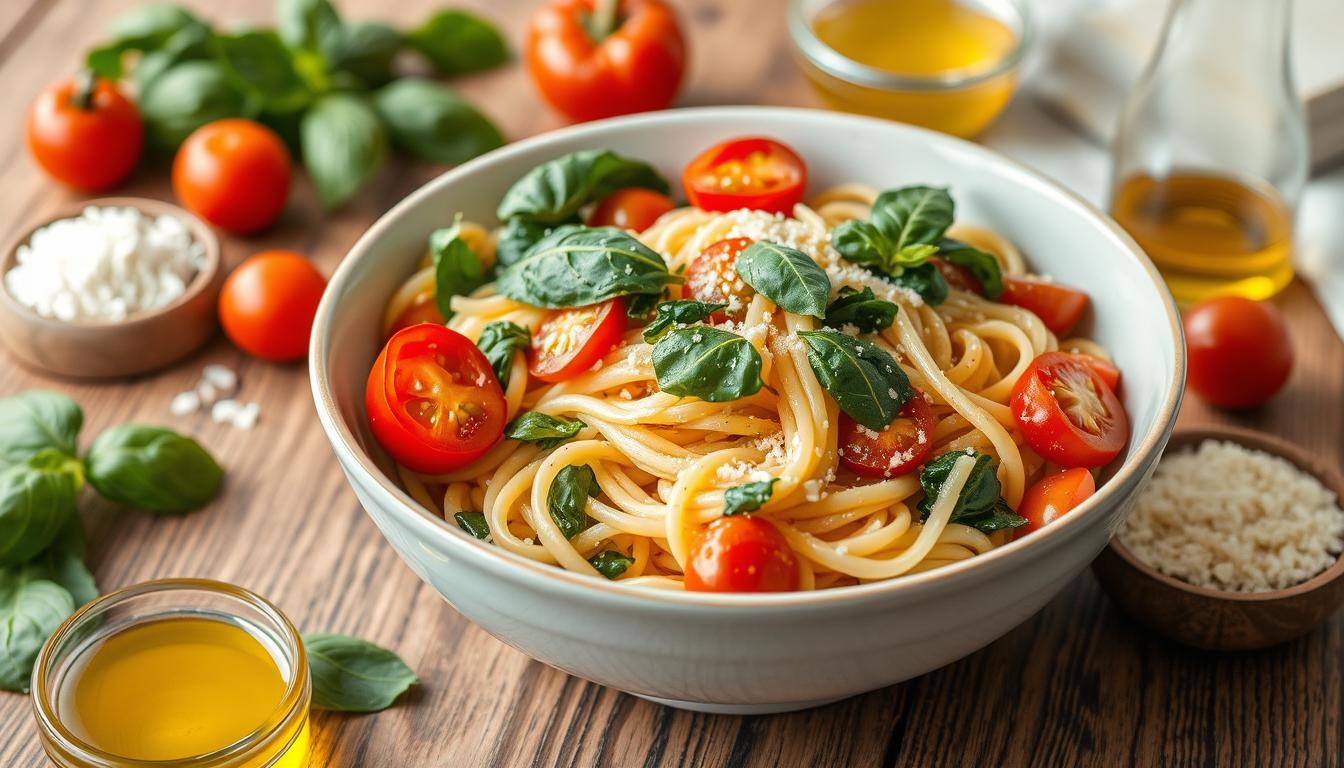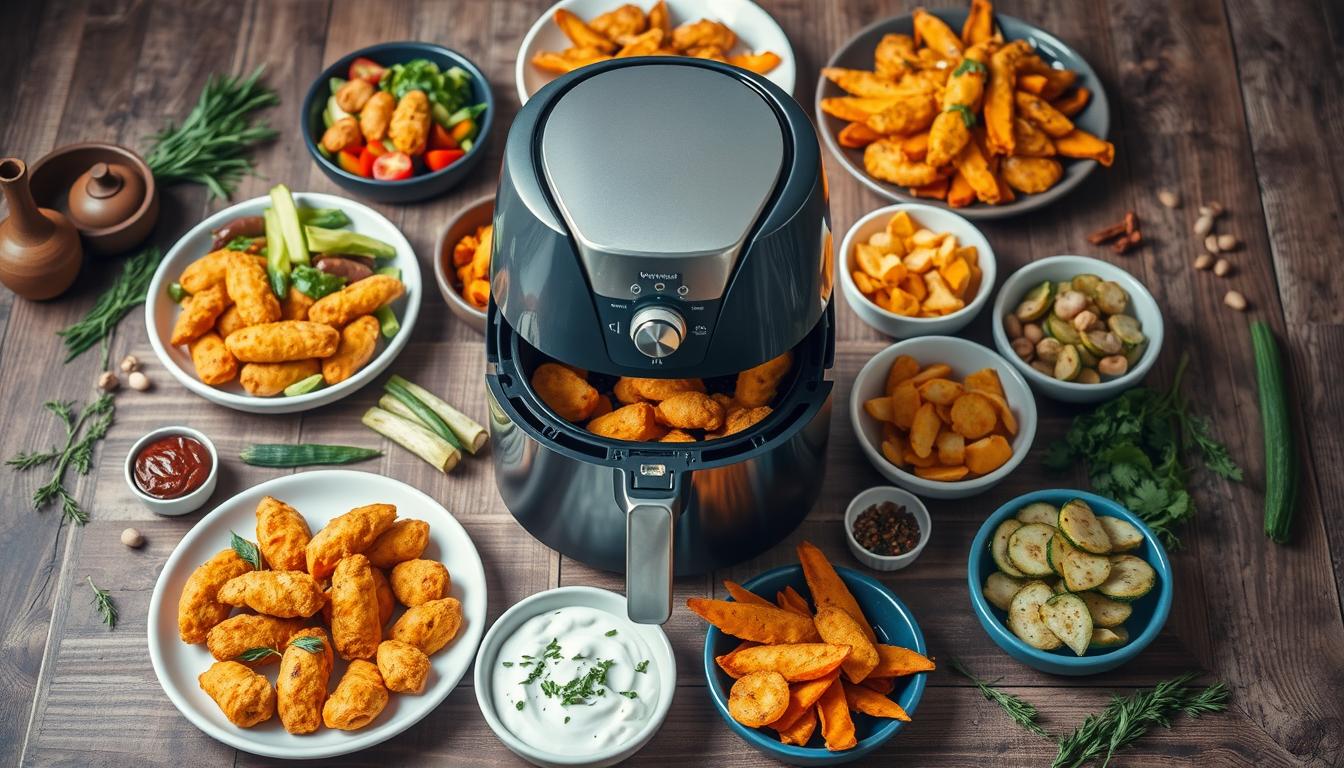Welcome to the universe of high volume low calorie recipes! If you’re eager to enjoy healthy eating recipes without sacrificing satisfaction, you’ve come to the right place. These recipes use wholesome ingredients for hearty meals without extra calories. You’ll find a variety of nutritious recipe ideas that keep you full and energized.
Whether you’re focused on weight management or just want tasty meals, our guide is for you. It will help you add these delightful dishes to your daily meals.

Key Takeaways
- High volume low calorie recipes are ideal for satisfying meals.
- These recipes help in maintaining a healthy weight.
- Fruits, vegetables, and lean proteins are key ingredients.
- Cooking techniques such as steaming can boost volume.
- Meal prep tips are essential for success with these dishes.
Introduction to High Volume Low Calorie Eating
High volume low calorie eating is all about eating foods that are low in calories but fill you up. You focus on foods like fruits, veggies, and lean proteins. This way, you can enjoy big, satisfying meals without eating too many calories.
Having meals that are high in volume but low in calories helps with weight control. Foods with lots of water or fiber, like leafy greens and berries, make you feel full. This helps prevent you from eating too much.
Trying out this way of eating opens up a world of tasty options. It’s a great way to eat well and enjoy your meals. It’s great for your wellbeing and encourages you.
Benefits of High Volume Low Calorie Recipes
High volume low calorie recipes are great for a healthy lifestyle. They help with weight management and make meals more satisfying. You can eat more without eating too many calories, making dieting easier.
Weight Loss and Management
These recipes are perfect for losing and managing weight. They let you eat big portions without too many calories. This makes you feel full and less tempted by unhealthy snacks.
Adding these meals to your diet supports your weight loss goals. It also helps you develop good eating habits.
Enhanced Meal Satisfaction
Eating more without feeling guilty is very satisfying. High volume meals are tasty and filling, making meals enjoyable. You can enjoy your food without worrying about calories.
This approach helps control hunger and promotes a balanced diet. It’s a win-win Situation for your Well-Being and taste buds.
Key Ingredients for High Volume Low Calorie Meals
To make high volume low calorie meals, pick ingredients that taste great and are good for you. Knowing the right ingredients is key to making healthy meals that fill you up without too many calories. Here are three important categories to think about:
Fruits and Vegetables
Fruits and vegetables are the base of any healthy meal. They’re full of fiber, which makes you feel full without adding too many calories. Try different colors like leafy greens, berries, and cruciferous veggies to get lots of vitamins and minerals.
Lean Proteins
It’s important to choose lean proteins for nutrition without extra calories. Options like chicken breast, turkey, fish, or plant-based foods like lentils and beans are great. They help keep your muscles strong and your calorie count low, making meals tasty and nutritious.
Whole Grains
Whole grains help keep you full and give you energy. Foods like quinoa, brown rice, and whole grain pasta add texture and flavor. They’re also packed with fiber and nutrients, making your meals healthier.
Cooking Techniques That Maximize Volume and Minimize Calories
Choosing the right cooking techniques is key in calorie-conscious cooking. Methods that boost meal volume while keeping calories low make food more enjoyable. Steaming, broiling, and utilizing flavors and spices are incredible choices.
Steaming and Roasting
These are top choices for keeping meals light and full of flavor. Steaming veggies keeps them fresh and sweet, without extra fats. Roasting caramelizes food, adding rich, complex tastes.
Spices and herbs are crucial in calorie-conscious cooking. They add flavor without calories. Fresh herbs like basil and spices like cumin make dishes exciting. This way, you enjoy tasty meals without extra calories..

Easy and Delicious High Volume Low Calorie Recipes
Exploring high volume low calorie recipes can change how you view healthy eating. These dishes are not only good for you but also tasty and fun. Here we have lot of quick and delicious ideas to be started.
Refreshing Salads
Salads are great for a light, healthy meal. Mix greens like spinach or kale with veggies like tomatoes, cucumbers, and bell peppers. A simple dressing of lemon juice and olive oil adds flavor without extra calories.
Adding proteins like grilled chicken or chickpeas makes the salad more filling. It’s a refreshing and satisfying choice.
Hearty Soups and Stews
Soups and stews are perfect for a cozy meal that’s low in calories. Use low-sodium broth as a base and add veggies like carrots, zucchini, and spinach. Lean proteins like turkey or beans add to the meal’s nutrition.
These dishes are warm, comforting, and filling. They are ideal for a cozy evening at home.
Creative Smoothies
Smoothies are a quick way to get more fruits and veggies into your diet. Blend your favorite fruits, like berries, bananas, and spinach, with yogurt or almond milk. Adding seeds or oats boosts the nutrition.
These smoothies are not just a tasty treat but also a healthy option for on-the-go meals.
Tips for Meal Prep: Ensuring Low Calorie Success
Effective meal prep is key for a healthy lifestyle, especially with low calorie meals. Organizing your cooking helps save time and ingredients. This leads to better meal consistency and satisfaction. Here are some tips for batch cooking and storage to keep your meals fresh.
Batch Cooking Techniques
Batch cooking lets you make a lot of food at once. This makes planning meals for the week easy. Here are some techniques to consider:
- Choose versatile recipes that can be varied. For example, make a big pot of vegetable soup and add different spices and toppings to each portion.
- Make freezer-friendly meals like chili, stir-fries, or grain bowls. These can be portioned and stored for weeks.
- Use quality containers for portioning meals. Vacuum-sealed bags keep food fresh and save freezer space.
Storage and Reheating Guidelines
Proper storage and reheating keep your meals tasty and nutritious. Follow these tips to keep your low calorie meals fresh:
- Keep cooked meals in airtight containers to prevent spoilage and keep flavors.
- Label containers with the date you made them.This helps you use older foods first.
- Reheat meals to 165°F to ensure safety. Use a microwave-safe dish with a cover to keep moisture in.

| Technique | Description | Benefits |
|---|---|---|
| Batch Cooking | Preparing large quantities of meals for the week. | Saves time and reduces cooking stress on busy days. |
| Portion Control | Dividing meals into single servings for easy access. | Helps maintain balanced portions and control calorie intake. |
| Airtight Storage | Using containers that seal tightly to keep food fresh. | Preserves flavors and nutritional value. |
| Proper Reheating | Ensuring meals are heated evenly and thoroughly. | Enhances taste and ensures food safety. |
Creative Ways to Incorporate High Volume Low Calorie Foods into Your Diet
Adding high volume low calorie foods to your meals makes them more interesting. It also helps you feel full without eating too many calories. Start your day with a big serving of veggies in your breakfast. For example, add spinach, tomatoes, or bell peppers to scrambled eggs.
Snacking can be fun with wraps or lettuce cups. Use romaine or green lettuce to wrap turkey, hummus, and cucumbers. This makes snacks light and refreshing. Try replacing chips with veggie sticks and a tasty dip for a crunchy snack.
For dessert, let fruits be the star. Make fruit salads or blend frozen berries into smoothies. Use apples or pears in baked goods for moisture and sweetness.
Here’s a table with tasty meal ideas that are easy to add to your week:
| Meal Type | Nutritious Recipe Ideas |
|---|---|
| Breakfast | Vegetable Omelet with Spinach, Tomatoes, and Onions |
| Snack | Turkey and Hummus Lettuce Wraps |
| Lunch | Chickpea Salad with Cucumbers, Red Onion, and Lemon Dressing |
| Dinner | Grilled Chicken with a Side of Steamed Broccoli and Cauliflower |
| Dessert | Mixed Berry Smoothie Bowl topped with Sliced Bananas |
Trying new ways to eat high volume low calorie foods makes your meals better. It helps you stay healthy while enjoying tasty foods.
High Volume Low Calorie Recipes for Quick Meals
In today’s fast world, healthy eating can seem hard. Quick low calorie dishes are a great fix. They offer tasty meals that are simple to make. Whether you’re busy at work or just want something easy, these recipes are perfect.
15-Minute Dishes for Busy Days
When time is tight, making meals can feel overwhelming. Here are some quick low calorie dishes ready in 15 minutes or less:
- Veggie Stir-Fry: Mix your favorite veggies with tofu or chicken. Sauté in soy sauce and serve over brown rice.
- Caprese Salad: Layer mozzarella, tomatoes, and basil. Add balsamic vinegar for a fresh treat.
- Avocado Toast: Spread avocado on whole-grain toast. Top with a poached egg and red pepper pieces.
On-the-Go Options
Keeping healthy on the go is key. Here are some portable meal ideas:
- Portable Salads: Layer greens, veggies, and proteins in mason jars. Shake for a fresh meal.
- Snack Packs: Mix sliced veggies, hummus, and whole-grain crackers in a container. A quick, healthy snack.
- Greek Yogurt Parfaits: Layer yogurt, fruits, and granola for a quick breakfast or snack.
These quick low calorie dishes save time and keep you healthy anywhere, anytime.
| Dish | Preparation Time | Calories (Approx.) |
|---|---|---|
| Veggie Stir-Fry | 10 minutes | 300 |
| Caprese Salad | 5 minutes | 250 |
| Avocado Toast | 5 minutes | 350 |
| Portable Salads | 15 minutes | 250 |
| Snack Packs | 10 minutes | 200 |
| Greek Yogurt Parfaits | 5 minutes | 150 |
How to Combine High Volume Dishes for Balanced Meals
Mixing different high volume dishes helps you make balanced meals that are low in calories but full of nutrients. It’s important to balance proteins, carbs, and healthy fats in your meals. Using healthy eating recipes that include various food groups is a great way to do this.
Try a simple meal prep method that uses lots of volume ingredients. For example, make a tasty salad with greens, grilled chicken, and quinoa. This mix gives you lean protein, complex carbs, and lots of fiber, making your meal satisfying.
| Food Component | Example Combination | Nutritional Benefits |
|---|---|---|
| Protein | Grilled salmon with steamed asparagus | Omega-3 fatty acids, vitamins A and C |
| Carbohydrates | Brown rice with black beans | Complex carbs, fiber, and protein |
| Healthy Fats | Avocado on whole grain toast | Monounsaturated fats, potassium, and fiber |
| Fruits and Vegetables | Mixed fruit bowl with plain yogurt | A blend of vitamins, minerals, and probiotics |
Try out these ideas to create your own low-calorie, high volume meals. Being creative in the kitchen not only meets your nutritional needs but also makes eating fun. It’s a great way to live a healthier life.
High Volume Low Calorie Recipes for Special Occasions
Celebrating special occasions often means enjoying tasty food. You can have fun without losing your health goals. Choose high volume low calorie recipes for memorable gatherings. These meals are full of flavor and keep calories low. Find healthy party dishes and seasonal treats that everyone will enjoy.
Healthy Party Dishes
Looking for low calorie meal ideas for your next party? Here are some recipes that everyone will love:
- Stuffed Mini Peppers: These bite-sized treats are filled with quinoa, black beans, and spices. They’re colorful and nutritious.
- Veggie Platters: Offer a variety of fresh veggies with a homemade yogurt dip. It’s a refreshing choice.
- Open-Faced Turkey Sliders: Use whole grain buns, lean turkey, sautéed onions, and a bit of mustard. It’s a tasty option.
- Fruit Skewers: Mix seasonal fruits for a sweet treat. It adds freshness to any table.
Seasonal Celebrations
Healthy eating recipes can be festive and fulfilling during festive times. Here are some ideas for your next celebration:
- Roasted Butternut Squash Salad: A warm salad with arugula, roasted squash, and a light vinaigrette is perfect for winter.
- Spring Vegetable Risotto: Use cauliflower rice for a light, creamy dish with spring veggies.
- Grilled Peach Dessert: Top it with low-fat Greek yogurt for a summer treat.

These low calorie meal ideas are great for health-conscious guests. They make parties more enjoyable. Enjoy food and connection without losing your dietary goals. Use these healthy recipes to make your celebrations unforgettable.
Conclusion
In this article, we’ve looked at the many benefits of high volume low calorie recipes. These recipes are great for those looking to lose weight but still enjoy their meals. They include fruits, vegetables, lean proteins, and whole grains, making your meals better and healthier.
By using different cooking methods, you can make big, filling meals without too many calories. This means you can enjoy tasty, healthy dishes easily. It makes it simple to stick to your diet goals.
Start trying out these recipes and tips. Every step towards eating more volume with fewer calories is a step towards better health. So, get cooking, be creative, and enjoy the delicious, vibrant meals that will support your journey.
Are you looking for something new to bake? There’s a whole world of delicious recipes out there waiting to be discovered. From classic favorites to innovative twists, there’s a recipe for every taste and occasion.
FAQ
What are high volume low calorie recipes?
High volume low calorie recipes are meals that are filling but low in calories. They use fruits, veggies, and lean proteins. This makes them great for healthy eating and losing weight.
How do high volume low calorie meals aid in weight loss?
These meals let you eat more without gaining weight. They assist you with getting more fit by encouraging you. This way, you’re less likely to snack on high-calorie foods.
Can you provide some quick low calorie dishes?
Yes! Quick low calorie dishes include fresh salads and hearty soups. You can also make smoothies with fruits and almond milk or yogurt.
What are key ingredients for high volume low calorie meals?
Key ingredients are fruits, veggies, lean proteins, and whole grains. They’re high in fiber and low in calories. This keeps you full and satisfied.
What cooking techniques help maximize volume while minimizing calories?
Steaming and roasting are great for keeping flavor and nutrients. Using spices and herbs also makes meals tasty without adding calories.
How can I successfully meal prep for low calorie meals?
Focus on batch cooking nutritious recipes. Use proper storage and reheating to keep meals fresh and flavorful.
How can I creatively incorporate high volume low calorie foods into my diet?
Add veggies to breakfast dishes and use fruits in desserts. These ideas keep your diet diverse and enjoyable while watching calories.
What are some high volume low calorie recipes suitable for special occasions?
Try veggie platters and seasonal salads for parties. You can also make lighter versions of favorite dishes that are still tasty.
What is calorie-conscious cooking?
It’s about choosing ingredients and techniques for dishes that are low in calories but still tasty. It focuses on high volume, low calorie options for healthy eating.
Where can I find nutritious recipe ideas for weight loss?
Look in cookbooks, blogs, and websites focused on healthy eating. Find resources with high volume low calorie recipes for meal ideas.





























2 Responses